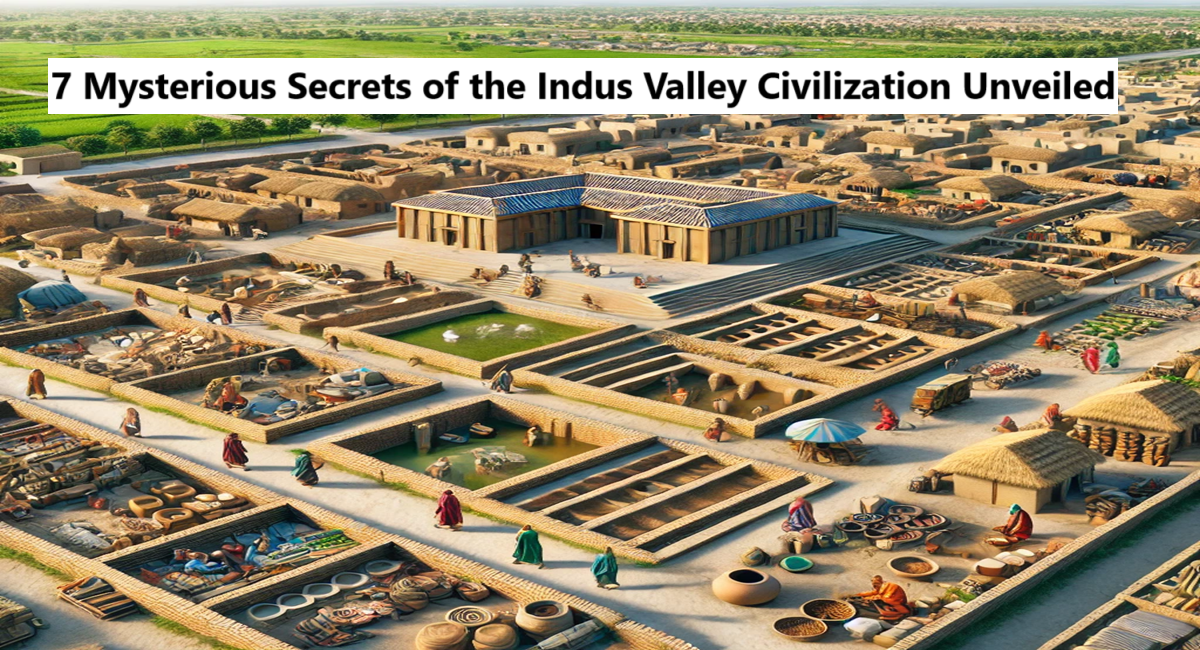One of the world’s earliest civilizations, the ancient Indus Valley Civilization flourished in the northwestern regions of South Asia from 3300–1300 BC, including present-day Pakistan and northwestern India This civilization is known as the Harappan civilization, and is derived its name from the first archaeological site, Harappa. The Indus Valley civilization was known for its innovative urban design, buildings, and infrastructure, and was a symbol of progress in the ancient world
7 Mysterious Secrets of the Indus Valley Civilization Unveiled
1. Undeciphered Script
One of the greatest mysteries of the Indus Valley Civilization is its script. Despite numerous attempts, the ancient script remains undeciphered, leaving many aspects of their culture, governance, and daily life a puzzle.
2. Advanced Urban Planning
The cities of Harappa and Mohenjo-Daro showcase exceptional urban planning skills. The grid-like city layout, advanced drainage systems, and well-organized residential and commercial areas reflect a high level of civil engineering and urban planning.
3. The Great Bath
Located in Mohenjo-Daro, the Great Bath is a massive, well-constructed water tank that suggests the importance of ritualistic bathing in the Indus Valley culture. Its purpose and the exact rituals associated with it remain a topic of speculation.
4. Mysterious Seals
Thousands of seals have been discovered at Indus Valley sites, often depicting animals, mythical creatures, and undeciphered script. The exact purpose of these seals is still unknown, though they are believed to have been used for trade or administrative purposes.
5. Unknown Reasons for Decline
The sudden decline of the Indus Valley Civilization around 1900 BCE is shrouded in mystery. Various theories include climate change, tectonic activity, river shifts, and invasions, but no definitive cause has been established.
6. Lack of Monumental Architecture
Unlike other contemporary civilizations, the Indus Valley Civilization lacks grand palaces, temples, or monuments. This absence raises questions about their societal structure, religious practices, and priorities.
7. Egalitarian Society
Archaeological evidence suggests that the Indus Valley Civilization had relatively little social stratification. There are no clear indications of a ruling class or significant wealth disparity, which contrasts with other ancient civilizations.
These secrets add to the allure and enigma of the Indus Valley Civilization, making it a fascinating subject of study and speculation. 🏛️📜
Harappa and Mohenjo-Daro
Harappa and Mohenjo-Daro are two famous cities of the Indus Valley Civilization. These old cities show elaborate urban planning and sophisticated culture around 2500 BC.
The ancient city of Harpa
Located in the Punjab province of present-day Pakistan, Harppa was one of the first cities to make important archaeological discoveries, giving the civilization a reputation Urban planning reflects an efficient grid system, magnificent sewers, and brick-paved streets. Beads, pottery, coins and other objects show the skill of the Harappans in craftsmanship. The rest of the city shows a vibrant country with wonderful networks of communication and commerce.
Mohenjo-Daro township
Mohenjo-Daro in Sindh, Pakistan is famous for its outstanding architecture, such as the iconic Great Bath, which is believed to have been used for rituals The collections include bronze statues, terracotta paintings and beautifully carved coins, revealing information about… aesthetic tastes and the daily activities of its people
Together, Harppa and Mohenjo-Daro reveal the creativity and austerity of the Indus Valley civilization, creating a lasting impact on historians and archaeologists worldwide. The findings play an important role in our understanding of the development of ancient human communities and urban life.
Ancient Indus Valley
A sophisticated civilization resided in the Ancient Indus Valley, known for its efficient organization and advanced technology. The residents of the Indus Valley constructed cities with remarkable infrastructures that included granaries, warehouses, and dockyards. The society also maintained a strong agricultural foundation, growing wheat, barley, peas, and cotton, which played a key role in their economy. The cities were designed in a grid layout, demonstrating sophisticated planning and a grasp of geometric principles.

Indus Valley Sites
There are many important Indus Valley sites scattered throughout present-day India, Pakistan, and even parts of Afghanistan. Key areas include:
- Harappa: the first city discovered, exhibiting complex urban planning.
- Mohenjo-Daro: Famous for the grand baths in an ancient public cistern.
- Dholvira: Located in Gujarat, it is famous for its unique water conservation scheme.
- Lothal: A port city known for its trade links with Mesopotamia.
- Kalibangan: Known for its fire altars and evidence of early agricultural practices.
History of the Indus Valley
The history of the Indus Valley civilization dates back to its emergence around 3300 B.C. They are divided into three parts:
- Early Harappan (3300–2600 BCE): This was the formative period when people in the Indus Valley began to develop their urban centers.
- Mature Harappan Phase (2600–1900 BCE): During this period, civilization reached its peak, and cities such as Harappa and Mohenjo-Daro flourished.
- Late Harappan Phase (1900–1300 BCE): This was a period of decline, where urban life gradually disappeared.
Indus Valley Culture
The ancient history of the Indus Valley Civilization, also called the Harappan Civilization, is incredibly intriguing due to its culture. Thriving in the northwestern areas of South Asia around 2500 BCE, this civilization displayed impressive progress in a variety of cultural areas.
Urban Planning and Architecture
The inhabitants of the Indus Valley were trailblazers in city organization. Their urban centers, like Harappa and Mohenjo-Daro, were designed in a grid layout with sophisticated sewage systems and carefully organized residential and commercial zones. Using baked bricks in their construction projects helped to guarantee the longevity of their buildings.
Art and Craftsmanship
The artistic accomplishments of the Indus Valley Civilization are well-known. The individuals crafted detailed jewelry, pottery, and sculptures. The well-known Dancing Girl statue from Mohenjo-Daro, crafted from bronze, is a perfect illustration of their advanced metalworking abilities. The seals made of steatite commonly show animals, mythological figures, and undeciphered scripts, displaying their skill and artistic abilities.
Economy and Trade
Commerce played a vital role in the Indus Valley civilization. They had a trade network that was firmly established and reached Mesopotamia, Oman, and maybe even Egypt. They engaged in the exchange of items like cotton textiles, beads, and pottery. The finding of consistent weight and measurements suggests a controlled economy.
Social Structure
Evidence indicates that the Indus Valley civilization had a relatively equal distribution of wealth and power. There is no clear evidence of an upper class or major wealth inequality. The way they plan their cities and ensure housing looks the same indicates a society that values community and sharing resources.
Religious Beliefs
Although their religious practices are not well understood, the existence of different figurines and seals indicates that they may have worshipped a mother goddess and a potential proto-Shiva entity. The importance of ritualistic bathing in their culture is highlighted by The Great Bath in Mohenjo-Daro.
Language and Script
An ongoing mystery of the Indus Valley Civilization is their undeciphered script. Scholars have been fascinated by the symbols discovered on seals and pottery for many years. Decoding this writing may offer an important understanding of their governmental, societal, and traditional customs.
Decline
Speculation continues about the decline of the Indus Valley Civilization around 1900 BCE. Potential causes could be climate change, tectonic movement, or incursions. Even though it has decreased in prominence, the impact and motivation from the Indus Valley Civilization still persist.
Archeology of the Indus Valley
Archeology plays an important role in understanding the Indus Valley Civilization. The discovery of Harappa and Mohenjo Daro in the 1920s was a breakthrough in South Asian archaeology. The excavations have unearthed thousands of items such as coins, pottery, tools, and even bones, giving us an insight into people’s lives Archaeologists continue to study these sites to learn more about social structures, economies, and civilizational culture.
Indus Valley Urban Planning
The urban planning of the Indus Valley civilization was impressive in its time. The cities were built in a grid system and the streets were laid out straight. The houses were built of baked brick, and many had private wells and bathrooms. Sophisticated sewer systems were being used throughout the cities, ensuring sanitation and public health. This elaborate city planning was unique among ancient civilizations and reflected elaborate Indus design.
Script of the Indus Valley
The script of the Indus Valley remains one of civilization’s most intriguing enigmas. There have been numerous seals and pottery fragments discovered with writings in this script, yet it still cannot be understood until now. The document is composed of symbols that are thought to depict a language or a method of conveying information. Unraveling this writing system could reveal numerous unknown facts about the Indus Valley Civilization, however, it remains a mystery to researchers and language experts.

Decline of the Indus Valley Civilization
There is much debate surrounding the decline of the Indus Valley Civilization. Different explanations have been suggested to understand its collapse, including different, natural failures or takeover by outside companies such as the Aryans. The Late Harappan phase shows signs of decreasing urban life, including a drop in population and a move towards living in rural areas. The specific reason for this downfall is still uncertain, but it signified the end of one of the most sophisticated societies of its era.
Artifacts from the Indus Valley
The items unearthed in the Indus Valley consist of pottery, rings, tools, and the well-known Indus seals. These seals often show animals like bulls, elephants, and unicorns, along with writing in the Indus script. The artifacts screen showcases the daily routines, commerce, and way of life of the civilization. Pottery found in the Indus Valley is renowned for its intricate patterns and skilled artistry.
Indus Valley Civilisation सिंधु घाटी सभ्यता के 7 रहस्यमय रहस्यों का खुलासा
Indus Valley Trade
Trade became a great part of the Indus Valley financial system. The people of this civilization engaged in nearby and worldwide trade. They traded items including cotton, grains, pottery, and jewelry with Mesopotamia, Persia, and other areas. The discovery of Indus seals in Mesopotamian towns is evidence of this long-distance trade. Lothal, one of the Indus Valley websites, changed into a chief port town that facilitated maritime trade.
Indus Valley Religion
The Religion of the Indus Valley Civilization remains fairly mysterious because of the shortage of decipherable texts. However, artifacts recommend that the humans worshiped quite a few deities, such as a probable proto-Shiva figure. The well-known seals often depict animals and human-like figures in meditative postures, hinting at early sorts of Hinduism or animistic beliefs. Evidence of fireplace altars at websites like Kalibangan indicates ritual practices associated with fire worship.
Indus Valley Technology
The Technology of the Indus Valley Civilization became beforehand of its time. They were professional in metallurgy, running with copper, bronze, lead, and tin. The people advanced advanced techniques for constructing homes, together with using standardized baked bricks. Their awesome water management systems, such as wells, reservoirs, and drainage structures, highlight their technological improvements in urban infrastructure.
Indus Valley Geography
The Geography of the Indus Valley played a crucial position in the development of its civilization. The fertile floodplains of the Indus River and its tributaries furnished adequate water for agriculture, permitting the civilization to flourish. The area’s proximity to the Arabian Sea facilitated alternatives, and the natural protection presented by way of the encompassing mountains and deserts helped steady the civilization from outside threats.

Indus Valley UPSC Notes
For students preparing for competitive exams like UPSC, the Indus Valley Civilization is an important topic in the history of ancient India. Understanding the timeline of the civilization, including urban planning, intact inscriptions, and major sites such as Harappa and Mohenjo-Daro, as well as its trade practices, cultural developments, and theories of decline will help us to answer relevant questions.
Indus Valley Civilization PDF
If you are looking for detailed information about the Indus Valley Civilization, the PDF download of the summary can be very helpful. Many educational websites and forums offer PDF materials on the history, culture, geography, and discoveries of all parts of the Indus Valley
Map of the Indus Valley
A map of the Indus Valley civilization is essential to understanding its geography and the location of its major cities. These maps tend to highlight major sites such as Harappa, Mohenjo-Daro, Dholaweera, and Lothal. They also pointed out the importance of the Indus and its tributaries for agricultural practices and trade routes of the civilization

The Discovery of the Indus Valley
Over the years, many discoveries have been made in the Indus Valley, shedding light on the life and culture of its inhabitants. The discovery of the Great Bath at Mohenjo-Daro, the fire altar at Kalibangan, and the harbor at Lothal are some of the most important discoveries ever made to add to our understanding of how the Indus Valley Civilization had developed and organized around.
Indus Valley Timeline
Indus Valley Timeline
The Timeline of the Indus Valley Civilization can be extensively divided into 3 stages:
- Early Harappan Phase (3300–2600 BCE): The formation of early settlements and development of change networks.
- Mature Harappan Phase (2600–1900 BCE): The height of urbanization and cultural achievements.
- Late Harappan Phase (1900–1300 BCE): The length of decline, marked through the abandonment of predominant cities.
Each phase contributes to the general know-how of the way the civilization developed, flourished, and eventually disappeared.
Who became the discoverer of the Indus Valley Civilization?
R.D. Banerjee and John Marshall were the first archaeologists to find out about the Indus Valley Civilization in 1920. Discoveries in Harappa and Mohenjo-Daro have uncovered historic civilizations, marking a great development in the know-how of early urban human existence.
Research performed in modern instances at the Indus Valley Civilization.
Modern technology like satellite TV for pc and 3D imaging have enabled researchers to uncover new data about the geographical volume of the Indus Valley civilization and its environmental elements, main to the revelation of several mysteries.
The Indus Valley Civilization remains one of the most charming and mysterious historical civilizations. Its properly deliberate towns, advanced era, and cultural richness hold to captivate historians, archaeologists, and college students alike. Even after centuries of having a look at, there is still plenty to study this wonderful civilization.
FAQs
What script did the Indus Valley Civilization use?
The Indus Valley Civilization used a unique script with symbols that remain undeciphered to this day, preventing us from fully understanding their language and records.
Why is the Indus Valley script significant?
The script is significant because it holds the key to understanding the administrative, social, and cultural aspects of the Indus Valley Civilization.
What were the key features of urban planning in the Indus Valley Civilization?
Key features included grid-patterned streets, advanced drainage systems, and well-organized residential and commercial zones.
How did the Indus Valley's urban planning contribute to their daily life?
Their sophisticated urban planning ensured efficient water management, sanitation, and convenient access to essential services, significantly enhancing their quality of life.
What is the significance of the Great Bath in Mohenjo-Daro?
The Great Bath is believed to have been used for ritualistic bathing, indicating the importance of cleanliness and ritual purification in their culture.
How was the Great Bath constructed?
The Great Bath was constructed using meticulously fitted bricks and a waterproofing technique, reflecting advanced engineering skills.
What are the seals of the Indus Valley Civilization?
The seals are small, carved objects made of steatite, often depicting animals, mythical creatures, and undeciphered script.
What was the purpose of the Indus Valley seals?
While their exact purpose remains unclear, they are believed to have been used in trade, administration, or as amulets.
What are some theories about the decline of the Indus Valley Civilization?
Theories include climate change, tectonic activity, shifting river patterns, and invasions.
When did the Indus Valley Civilization decline?
The civilization began to decline around 1900 BCE, although the exact timeline varies among scholars.
Did the Indus Valley Civilization build monumental structures?
Unlike other ancient civilizations, the Indus Valley Civilization did not build grand palaces, temples, or monuments.
Why is the absence of monumental architecture in the Indus Valley Civilization significant?
This absence raises questions about their societal structure, religious practices, and priorities, suggesting a possibly egalitarian society.
Was the Indus Valley Civilization an egalitarian society?
Archaeological evidence suggests relatively little social stratification, with no clear indications of a ruling class or significant wealth disparity.
How did the egalitarian nature of the Indus Valley Civilization impact their society?
This likely fostered a more cooperative and community-oriented society, with shared responsibilities and resources.




